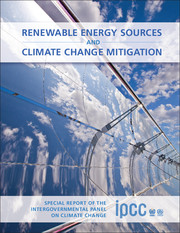 Renewable Energy Sources and Climate Change Mitigation
Renewable Energy Sources and Climate Change Mitigation Book contents
- Frontmatter
- Contents
- Section I
- Section II
- Section III
- Chapter 1 Renewable Energy and Climate Change
- Chapter 2 Bioenergy
- Chapter 3 Direct Solar Energy
- Chapter 4 Geothermal Energy
- Chapter 5 Hydropower
- Chapter 6 Ocean Energy
- Chapter 7 Wind Energy
- Chapter 8 Integration of Renewable Energy into Present and Future Energy Systems
- Chapter 9 Renewable Energy in the Context of Sustainable Development
- Chapter 10 Mitigation Potential and Costs
- Chapter 11 Policy, Financing and Implementation
- Section IV
- Index
- References
Chapter 11 - Policy, Financing and Implementation
Published online by Cambridge University Press: 05 December 2011
- Frontmatter
- Contents
- Section I
- Section II
- Section III
- Chapter 1 Renewable Energy and Climate Change
- Chapter 2 Bioenergy
- Chapter 3 Direct Solar Energy
- Chapter 4 Geothermal Energy
- Chapter 5 Hydropower
- Chapter 6 Ocean Energy
- Chapter 7 Wind Energy
- Chapter 8 Integration of Renewable Energy into Present and Future Energy Systems
- Chapter 9 Renewable Energy in the Context of Sustainable Development
- Chapter 10 Mitigation Potential and Costs
- Chapter 11 Policy, Financing and Implementation
- Section IV
- Index
- References
Summary
Executive Summary
Renewable energy can provide a host of benefits to society. In addition to the reduction of carbon dioxide (CO2) emissions, governments have enacted renewable energy (RE) policies to meet a number of objectives including the creation of local environmental and health benefits; facilitation of energy access, particularly for rural areas; advancement of energy security goals by diversifying the portfolio of energy technologies and resources; and improving social and economic development through potential employment opportunities. Energy access and social and economic development have been the primary drivers in developing countries whereas ensuring a secure energy supply and environmental concerns have been most important in developed countries.
An increasing number and variety of RE policies–motivated by a variety of factors–have driven substantial growth of RE technologies in recent years. Government policies have played a crucial role in accelerating the deployment of RE technologies. At the same time, not all RE policies have proven effective and efficient in rapidly or substantially increasing RE deployment. The focus of policies is broadening from a concentration almost entirely on RE electricity to include RE heating and cooling and transportation.
RE policies have promoted an increase in RE capacity installations by helping to overcome various barriers. Barriers specific to RE policymaking (e.g., a lack of information and awareness), to implementation (e.g., a lack of an educated and trained workforce to match developing RE technologies) and to financing (e.g., market failures) may further impede deployment of RE.
- Type
- Chapter
- Information
- Renewable Energy Sources and Climate Change MitigationSpecial Report of the Intergovernmental Panel on Climate Change, pp. 865 - 950Publisher: Cambridge University PressPrint publication year: 2011
References
- 21
- Cited by


